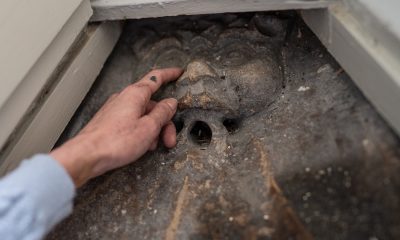By Mark Waghorn via SWNS
A spectacular new type of stegosaur with spear-like bones fused to its thighs has been dug up in China.
The fearsome-looking beast also had a spiked tail - and its back was studded with large traingular plates.
via GIPHY
It is believed to be one of the oldest members of the iconic stegosaurs - and was unlike anything else in the animal kingdom.
The new species has been named Bashanosaurus primitivus - Latin for first.
It roamed Earth around 168 million years ago during the Middle Jurassic - shedding fresh light on their evolution.
The bizarre armor would have been used to fight off meat-eating predators like Allosaurus and Ceratosaurus.
Allosaurus fossils have been found with large holes thought to be made by a stegosaur's tail spike.
The natural weaponry also acted as a thermo-regulatory mechanism to keep the creature cool - and helped attract mates.
Lead author Dr. Dai Hui, of Chongqing Bureau of Geological and Mineral Resource Exploration, said: "All these features are clues to the stegosaurs' place on the dinosaur family tree.
"Bashanosaurus can be distinguished from other Middle Jurassic stegosaurs - and clearly represents a new species.
"What's more, our analysis of the family tree indicates it is one of the earliest-diverging stegosaurs along with the Chongqing Lizard (Chungkingosaurus) and Huayangosaurus.
"These were all unearthed from the Middle to Late Jurassic Shaximiao Formation in China - suggesting that stegosaurs might have originated in Asia."
They have been depicted on TV and in movies like the second and third installments of the Jurassic Park franchise.
Bashanosaurus was about nine foot long and weighed more than a ton. Its remains included bones from the back, shoulder, thigh, feet and ribs.
Several armor plates were also discovered at the site in Chongqing, south west China.
It is not known if they belonged to an adult or a juvenile. Stegosaurs could reach 30 feet - and weigh up to eight tons.
The fossilised skeleton dates back to the Bajocian stage of the Middle Jurassic - much earlier than most known stegosaurs.
Dr. Hui said: "Bashanosaurus is the oldest stegosaur discovered in Asia - and possibly the world."
It has a smaller and less developed shoulder blade, narrower and thicker bases to its armor plates.
Other features - including two bones sticking out from either side of its body - are also unique.
But it also shares some similarities the first armoured dinosaurs - which are over 20 million years older.
Stegosaurs are instantly recognizable by their huge back plates, long tail spikes and tiny heads.
The four-legged plant-eaters lived during the Jurassic and early Cretaceous.
They had a beak to eat ferns and other low-lying plants such as moss.
Their brain was about the size of a walnut - meaning they were among the most dim-witted dinos.
Stegosaur fossils have been found on all continents except for Antarctica and Australia - with 14 different species identified so far.
They range from primitive Huayangosaurus to Gigantspinosaurus and Miragaia - notable for enormous shoulders and an extremely long neck, respectively.
But the fragmentary material has hindered attempts to understand how the stegosaurs evolved or relate to one another.
Bashanosaurus fills important pieces in the puzzle. It has several primitive features like those of Huayangosaurus, Gigantspinosaurus and early armored dinosaurs.
But the bony point at the end of the shoulder blade is small and less well developed than in other stegosaurs.
The bony projection of the thigh bone is positioned below the middle of the shaft and the bases of the armour plates curve outwards.
They are also thicker than the plates on the backs of its later relatives.
Co-author Dr. Susannah Maidment, of London's Natural History Museum, said: "The discovery of this stegosaur from the Middle Jurassic of China adds to an increasing body of evidence that the group evolved in the early Middle Jurassic, or perhaps even in the Early Jurassic, and as such represent some of the earliest known bird-hipped dinosaurs.
"China seems to have been a hotspot for stegosaur diversity, with numerous species now known from the Middle Jurassic right the way through until the end of the Early Cretaceous period."
Bashanosaurus is described in the Journal of Vertebrate Paleontology.


 Food & Drink1 week ago
Food & Drink1 week ago
 Broadcast1 week ago
Broadcast1 week ago
 Parenting18 hours ago
Parenting18 hours ago
 Broadcast1 week ago
Broadcast1 week ago
 Broadcast3 days ago
Broadcast3 days ago
 Broadcast1 week ago
Broadcast1 week ago
 Funny1 week ago
Funny1 week ago
 Broadcast2 days ago
Broadcast2 days ago





















